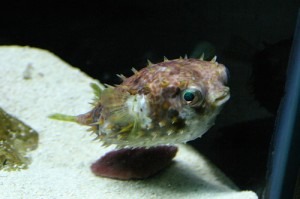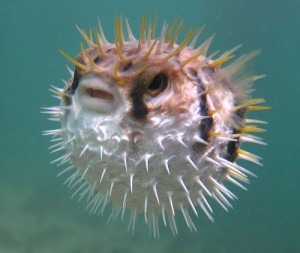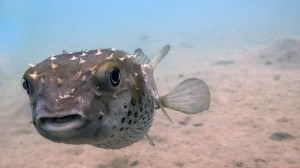Tetraodontidae is a family of primarily marine and estuarine fish of the order Tetraodontiformes. The family includes many familiar species, which are variously called pufferfish, puffers, balloonfish, blowfish, bubblefish, globefish, swellfish, toadfish, toadies, honey toads, sugar toads, and sea squab. I like Pufferfish so we are going with that.
Almost all pufferfish contain tetrodotoxin, a substance that makes them foul tasting and often lethal to fish. To humans, tetrodotoxin is deadly, up to 1,200 times more poisonous than cyanide. Pufferfish are generally believed to be the second-most poisonous vertebrates in the world, after the golden poison frog. There is enough toxin in one pufferfish to kill 30 adult humans, and there is no known antidote. Certain internal organs, such as liver, and sometimes the skin, contain the tetrodotoxin and are highly toxic to most animals when eaten; nevertheless, the meat of some species is considered a delicacy in Japan, Korea and China. In Japan this pufferfish meat is called fugu and is extremely expensive and only prepared by trained, licensed chefs who know that one bad cut means almost certain death for a customer. In fact, many such deaths occur annually.
There are more than 120 species of pufferfish worldwide. Most are found in tropical and subtropical ocean waters, but some species live in brackish and even fresh water. They have long, tapered bodies with bulbous heads. Some wear wild markings and colors to advertise their toxicity, while others have more muted or cryptic coloring to blend in with their environment.
The puffer fish can grow to up to 60cm in length. Pufferfish can be found in a variety of colors but can sometimes be hard to identify when they are not inflated. The pufferfish normally has the appearance of a large tadpole, with bulging eyes and an elongated snout.
According to SoftSchools.com the most elastic part of their body is skin on the stomach area. When puffer fish ingests air or water, skin on the stomach expands several times of the normal size of the fish. When the pufferfish is threatened it inflates it’s body with air and water exposing the long, sharp, toxic spikes which normally intimidates the predator into retreating. If however, an animal does manage to eat the pufferfish, it will often be poisoned by the toxins in the spikes or the toxin that is released from the organs of the pufferfish when it dies. Despite the toxins in the pufferfish, some animals such as sharks are able to eat the puffer fish without becoming harmed. Biologists think pufferfish developed their famous “inflatability” because their slow, somewhat clumsy swimming style makes them vulnerable to predators.
According to National Geographic, the diet of the pufferfish includes mostly invertebrates and algae. Large specimens can crack open and eat clams, mussels, and shellfish with their four huge teeth. I wonder who would win in a fight? The Pufferfish or the Honey Badger? What do you think?
I remember as a child I had a taxidermied pufferfish that I hung from my bedroom ceiling. I believe though, like the elusive Panda Bear that I have yet to see, I have only ever seen one alive at the aquarium at Silverton Casino in Las Vegas yet when I do see them swimming around there, it always makes me smile.
Have you ever seen a pufferfish? Or maybe a more interesting question – Would you ever eat one? Let me know in the comments. Would love to hear from you.



